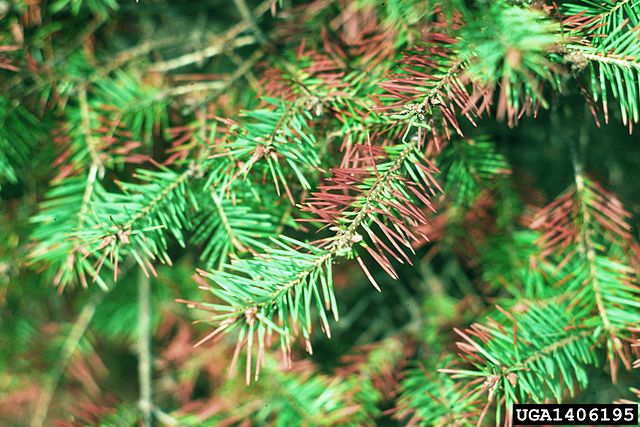Introduction
Swiss needle cast is an important fungal disease of Douglas-fir. It is one of the most common diseases to afflict Douglas-fir, alongside Rhabdocline needle cast. Swiss needle cast infections are caused by the pathogen Phaeocryptopus gauemannii. The fungus is indigenous to the historic range of Douglas-fir in western North America. The disease was first documented in Switzerland in 1925. The pathogen was discovered to have spread throughout several Douglas-fir plantations. It was subsequently designated the name Swiss needle cast.
Swiss needle cast infects Douglas-fir needles. Infected needles become discolored, eventually turning brown. Infected needles are often prematurely shed. When this occurs, infected Douglas-firs suffer from at least a partial defoliation. Successive defoliations can cause infected trees to decline, inhibiting the development of healthy plant growth. Douglas-firs that are infected by Swiss needle cast often assume a gnarled or malformed appearance. Outbreaks of Swiss needle cast can quickly sweep across landscapes, gardens, and Christmas tree nurseries. Swiss needle cast infections can render Douglas-firs unsuitable for sale as Christmas trees.
Distribution & Habitat
Swiss needle cast occurs through North America, Western Europe, Great Britain, Australia, Chile, and New Zealand.
Hosts
Swiss needle cast targets Douglas-fir. Rocky Mountain varieties are especially prone to infection.
Disease Cycle
The disease pathogen overwinters on previously infected needles. By early winter, black, spherical fruiting bodies arise on the underside of the diseased needles. In spring, the fruiting bodies mature, just as bud burst commences. The mature fruiting bodies produce and contain sexual spores called ascospores. When conditions are moist, usually from spring showers, the fruiting bodies rupture and release the ascospores into the air. The ascospores are disseminated by splashes of rain or air currents to vulnerable needles, which they land on. The spores rapidly germinate on the surface of the needles.
Once established, the spores penetrate into the needles through needle wounds and stomata. The spores infect new shoots as they first expand. They will sometimes infect the previous year’s needles as well. Needles that have fully expanded are generally less prone to infection. Once an infection has been initiated, additional fruiting bodies may form and expel ascospores. If conditions are favorable, Swiss needle cast infections can occur throughout the growing season. In fall, as cool temperatures prevail, the pathogen ceases activity and overwinters in the infected needles, beginning the cycle anew.
Symptoms of Infection
Symptoms of Swiss needle cast infection become apparent within 2 to 3 years. Diseased needles become discolored, brightening to yellow-green or yellow. This is followed by a browning of the needles, which begins at the tips and proceeds inward. Needle that have browned may drop prematurely. The black fruiting bodies appear as two tiny bands of structures arising on the underside of chlorotic or brown needles. The fruiting bodies can be observed throughout the year using a hand lens. The fruiting bodies measure about 0.1 mm in diameter. Swiss needle cast is often found on Douglas-firs infected with Rhabdocline needle cast.
Management
- Monitor for the appearance of the fruiting bodies in late winter. If the fruiting bodies are present, promptly remove the diseased branch or shoot. Disinfect pruning equipment in between each cut, using a solution composed of nine parts water and one part bleach. Thoroughly dry equipment thereafter to prevent rusting.
- Fungicidal applications can prevent infections from occurring, particularly on small to medium-sized Douglas-firs. Initial applications should be performed in spring, when shoots begin to expand. Administer a second application 2 to 3 weeks later. If rainfall is abundant, additional applications may be necessary to achieve sufficient control.
- When planting, select disease-resistant varieties. Douglas-fir seed originating from the Pacific Coast appears to exhibit a mild to moderate resistance to Swiss needle cast. Plant Douglas-firs in well-drained, moist soil. Provide adequate spacing between plants to promote healthy growth. Avoid planting near forests or on slopes.
- Cull severely infected Douglas-firs to reduce sources of inoculum.
- Maintain tree vigor through sound cultural practices. Ensure that trees are thoroughly watered, especially during extended periods of drought.
- In spring and fall, apply a layer of organic mulch around the base of vulnerable plants to improve the soil conditions, and insulate the root system. Mulch should be administered in fall after trees have become dormant.
- Remove weeds from around the base of Douglas-firs.


